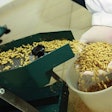Stem rust is an age-old disease that has stricken a variety of grain crops since ancient times, and has the tenacity to nearly destroy an entire wheat crop.
Over the past 50 years the United States and other developed nations have experienced measurable success in fighting this pathogen using a resistance gene called Sr31, a gene for which no virulence had been reported anywhere in the world.
However, after years without incident, a new type of wheat rust has emerged in Africa, puzzling scientists and researchers across the globe. The USDA Agricultural Research Service, in conjunction with the international research community, comprised of both private industry and government agencies, is dedicated to discovering how to combat this new race before it reaches the rest of the world.
New threat
The wheat industry and grain research community were thrown for a loop when in 1999, in a nursery in Uganda, Africa, susceptible type stem rust pustules were found on wheat lines known to have the stem rust resistance gene, Sr31. This new race of wheat rust is now labeled Pgt-Ug99.
Dr. Bob Bowden, research leader, Plant Science and Entomology Research Unit of the USDA-ARS based at Kansas State University, recalls his reaction upon first hearing about Ug99. “We were taken by surprise because the gene Sr31 had worked for a long time in a wide range of places,” he says. “We truly thought it was working everywhere and it quickly became popular to use in many different varieties from spring wheat to hard winter wheat. Sr31 is also linked to resistance to other diseases and possesses several agronomically useful traits, so it was surprising and dismaying to hear it had been overcome.”
Since its discovery, outbreaks of Ug99 have been confirmed in Kenya, Ethiopia, Yemen and Iran. Researchers predict the pathogen’s movement isn’t over yet. “In the course of several years it’s made its way east out of Africa,” Bowden says. “So we expect that this could affect all of Asia in the next few years.”
Nearly all wheat varieties planted in the world, including the United States, are susceptible to Ug99, making it a serious global concern. Because of the severity and scope of this pathogen, the Borlaug Global Rust Initiative was created to help combat Ug99 and its derivatives using a multinational and multidisciplinary research approach.
USDA-ARS researchers based out of St. Paul, MN, Raleigh, NC and Manhattan, KS are all playing key roles in the development of new resistance genes. But staying ahead of Ug99 and other wheat rust races is difficult because of its ability to mutate and overcome resistance genes.
Ever-changing enemy
One of the most challenging aspects of combating Ug99 is the fact that it is constantly mutating and possibly even undergoing sexual recombination, resulting in several derivatives of the original race.
Dr. John Fellers, research molecular biologist at USDA-ARS in Manhattan, KS, says that although this pathogen is more aggressive than what’s been documented in the past, it is definitely not unexpected that a pathogen would mutate over time. “This will always be an issue, but as a community we know that rust changes and farmers know a new variety is not good forever,” he says. “So we constantly have to be working on it and making new varieties, getting new genes so the farmers have something to work with.”
Because of the pathogen’s ability to evolve so quickly, some genes that had worked against Ug99 are no longer working. “We made some calculations to see what percentage of varieties in the United States were vulnerable to Ug99 and although that figure wasn’t promising, we did have some resistant varieties,” says Bowden. “In the meantime, however, the pathogen has defeated some of the varieties we thought were good, so we had to lower our estimate of how many resistant varieties we have if it were to come here.”
Researchers are currently pursuing two solutions using genetic research to create new rust-resistant varieties that can stand up to Ug99 for an extended period of time.
Dual strategies
One approach researchers at K-State are working on is dubbed the major gene approach. The major gene fights wheat rust using a sort of pathogen recognition system. When the plant is attacked by a pathogen that the major gene recognizes as dangerous, it rejects the pathogen and effectively beats the wheat rust.
But Bowden says the major gene has its flaws. “Using the major gene makes the plant very resistant, but not very durable, meaning that it can work effectively one year, but be defeated by the pathogen the next year,” he says. “The pathogen can eventually mutate to camouflage itself and not be recognized, and that’s how the major gene is defeated,” he says.
However, researchers have not abandoned the idea altogether. Bowden says there are theoretical reasons to believe that instead of using one major gene, using multiple major genes in combination should create a long-lasting variety. This combination is referred to as a gene stack or pyramid.
The second approach is referred to as the minor gene theory. Individually, minor genes are not as effective as a singular major gene in defeating wheat rust, but stacking several minor genes together can potentially create a good resistant variety. It is similar to the first approach in that it stacks multiple genes, but what’s different is the mechanism of resistance to the pathogen. It doesn’t rely on pathogen recognition to defeat rust, but rather strengthens the basic defense system of the plant. Once the gene stack is strong enough to defeat a pathogen, the wheat rust may never overcome it. The problem lies in finding enough effective minor genes to strengthen the defense to a point where it will successfully defeat the pathogen.
“Minor genes are more difficult to work with because there haven’t been very many discovered for stem rust, but we believe they’re out there,” says Bowden.
At this point, researchers are putting equal amounts of effort toward both solutions so they can maximize their chances of success.
Providing producers with multiple resistant wheat varieties would be an ideal scenario says Fellers. He explains why planting only one resistant variety across a large region can have consequences. He draws on his experiences with wheat leaf rust, a disease similar, but unrelated, to Ug99.
“We saw an epidemic like Ug99 in leaf rust about five years ago,” Fellers says. “All the farmers were using the same variety from Oklahoma through Nebraska so when the pathogen changed and was able to overcome that one particular resistance gene, it affected the entire region.”
Researchers remain hopeful that Ug99 will be stopped before having devastating effects in the United States or worldwide. An alarm has been raised up around the globe for the past several years by international researchers. The Borlaug Global Rust Initiative is bringing together researchers from the United States, CIMMYT (International Center for Maize and Wheat Improvement based in Mexico City), as well as Asia, Australia, Europe and Africa.


















